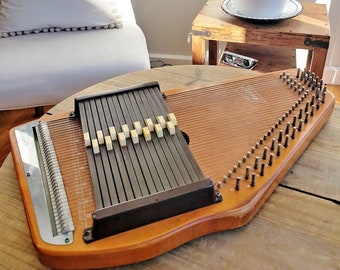

It is my own observation that their resale value tends to hold up over time (assuming the instrument has not been abused), but think 60-70% of what you paid, not 90% of what you paid.ĭepending on your budget, you can expect to pay in the range of US $600 - $1000 for a good refurb instrument.
#VINTAGE AUTOHARP VALUE WINDOWS#
There are some specific models and time windows for Oscar Schmidt autoharps that, when properly refurbished and set up, make instruments that are a pleasure to play and to own. Once that is done, the price is much the same as the next step, which is what you are contemplating, a refurbished vintage instrument. Janis Joplin also played the autoharp, which can be heard in her early, unreleased recording “So Sad to Be Alone”.First, I would personally ***NEVER*** advise anyone to purchase a current factory made autoharp except through a top end luthier who can set it up and correct the issues that come straight from the factory with these "instruments". Outside of bluegrass and country music, both acoustic and electric autoharp were occasionally used in the folk-influenced parts of late 1960s/1970s progressive rock, psychedelia and related genres by e.g. I still envision Dolly Parton playing that white bedazzled autoharp (pictured right) that you can see for yourself at the Dolly Parton museum inside Dollywood. Grand Ole Opry star Cecil Null was the first to develop the upright style for playing the autoharp that was in turn used by the Carter Family. They are relatively easy to learn to play as a rhythm instrument, but offer great rewards to the more committed player as a melody instrument. Gütter’s instrument design became very popular and Zimmermann has often been mistaken as the inventor.Īutoharps have been used in the United States as bluegrass and folk instruments, perhaps most famously by Maybelle Carter and Sara Carter of The Carter Family (Click on the picture at left to learn more about The Carter Family). Zimmermann, after returning from a visit to Germany, began production of the Gütter design in 1885…but with his own design patent number and catchy name. Gütter obtained a British patent for his instrument circa 1883-1884.


Karl August Gütter of Markneukirchen, Germany, had built a model that he called a “Volkszither” which most resembles the autoharp played today. It is not known if Zimmermann ever commercially produced any instruments of this early design. Unlike later autoharps, the shape of the instrument was symmetrical, and the felt-bearing bars moved horizontally against the strings instead of vertically. Zimmermann was awarded US patent 257808 in 1882 for a design for a musical instrument that included mechanisms for muting certain strings during play. A German immigrant in Philadelphia by the name of Charles F. There is debate over the origin of the autoharp. Despite its name, the autoharp is not a harp at all, but a chorded zither.
#VINTAGE AUTOHARP VALUE SERIES#
The autoharp is a musical stringed instrument having a series of chord bars attached to dampers which, when depressed, mute all the strings other than those that form the desired chord. She needs a little cleaning and, no doubt, a lot of tuning, but I have my fingers crossed that she will sing in time for our August 19th & 21st showcases at the IndieGrrl Music Conference in Knoxville.Īnd for those of you that can keep a secret, I’ve located an 1890 Zimmerman Chorded Zither called, of all things, The Favorite too…ĭo you think I can sneak it in when Jon isn’t looking?įor those of you unfamiliar with the autoharp, here’s a little lesson from : But I’ve been fussy about the condition and concerned about not buying it in person.īut, the day has come, and I now await my little 1953 Oscar Schmidt 12-Chord Autoharp (pictured below)… I’ve been looking for a vintage Oscar Schmidt Autoharp for a while now.


 0 kommentar(er)
0 kommentar(er)
